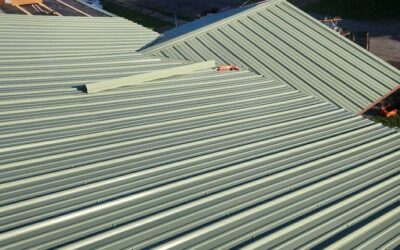How to Prevent Ice Dams in Northeast Ohio
Winter in Northeast Ohio can be brutal, with freezing temperatures, heavy snowfall, and strong winds coming off Lake Erie. These conditions create the perfect environment for ice dams, which can cause significant damage to your roof and home. In this guide, we’ll cover everything you need to know about preventing ice dams, including why they form, the risks they pose, and the best strategies to keep your roof safe.
Understanding Ice Dams
Ice dams form when heat escapes from your attic, warming the roof and causing snow to melt. As the water runs down the roof and reaches the colder eaves, it refreezes, forming a thick ridge of ice. Over time, this ice buildup prevents proper drainage, leading to water seeping under shingles and causing leaks.
Why Are Ice Dams a Big Problem in Northeast Ohio?
Northeast Ohio experiences harsh winters due to:
- Cold Winds from Lake Erie: The lake effect snow and freezing winds make winter particularly intense, increasing the likelihood of ice dam formation.
- Fluctuating Temperatures: Temperature swings between freezing and thawing contribute to snow melting and refreezing cycles.
- Heavy Snowfall: Thick layers of snow trap heat, accelerating the melting and refreezing process.
Given these factors, homeowners in the region must take proactive steps to prevent ice dams before they cause costly roof damage.
How to Prevent Ice Dams
1. Improve Attic Insulation
One of the most effective ways to prevent ice dams is by keeping your attic cold. The goal is to minimize heat transfer from your living space into the attic, which prevents snow from melting prematurely.
- Check Your Insulation Levels: The U.S. Department of Energy recommends at least R-49 insulation in attics for cold climates.
- Seal Air Leaks: Use spray foam or caulk to seal gaps around pipes, vents, and light fixtures to prevent warm air from escaping into the attic.
- Consider Blown-In Insulation: This is an effective way to add insulation to your attic while minimizing gaps.
2. Proper Roof Ventilation
A well-ventilated attic helps maintain a consistent temperature across the roof, reducing the risk of ice dam formation.
- Soffit and Ridge Vents: These vents allow cold air to flow in through the soffits and exit through the ridge, preventing heat buildup.
- Gable Vents: In some homes, gable vents can improve airflow and balance attic temperature.
- Keep Vents Clear: Blocked vents reduce airflow, so ensure they remain free of debris and insulation.
3. Use Heated Cables
Heated roof cables can be installed along the eaves to prevent ice from forming in critical areas.
- Installation: Secure them in a zig-zag pattern along the lower edges of your roof.
- Best for High-Risk Areas: These cables are useful for homes that have chronic ice dam issues, especially in valleys and north-facing slopes.
4. Keep Gutters and Downspouts Clear
Clogged gutters and downspouts can trap melting snow, leading to ice buildup.
- Clean Gutters Before Winter: Remove leaves, twigs, and other debris before the first snowfall.
- Install Gutter Guards: These help prevent debris accumulation and improve water flow.
- Check for Ice Blockages: If gutters freeze, use warm water or a roof rake to clear minor ice buildups.
5. Remove Snow from Your Roof
Reducing the snow load on your roof helps minimize ice dam formation.
- Use a Roof Rake: A long-handled roof rake allows you to clear snow from the ground without climbing onto the roof.
- Be Careful with Ice Scrapers: Avoid damaging shingles when removing ice.
- Hire Professionals: If snow accumulation is excessive, consider hiring a roofing contractor to safely remove it.
6. Upgrade to Ice & Water Shield Underlayment
If you’re replacing your roof, consider installing an ice and water shield underlayment beneath the shingles.
- Provides an Extra Layer of Protection: This material helps prevent water from seeping into your home if ice dams do form.
- Required by Code in Many Areas: Many roofing codes in Ohio mandate the use of this underlayment along eaves and valleys.
7. Monitor Indoor Humidity Levels
High indoor humidity can contribute to attic condensation, increasing the risk of ice dams.
- Use a Hygrometer: This tool measures humidity levels in your attic.
- Improve Ventilation: Use exhaust fans in kitchens and bathrooms to reduce excess moisture.
- Consider a Dehumidifier: If attic humidity remains high, a dehumidifier can help regulate moisture levels.
What to Do If Ice Dams Form
Despite taking precautions, ice dams may still develop. If you notice ice buildup along your roof edges, take these steps:
- Use Calcium Chloride Ice Melt: Sprinkle calcium chloride (not rock salt) over the ice dam to speed up melting.
- Create Drainage Channels: Fill a nylon stocking with ice melt and place it perpendicular to the dam to create drainage paths.
- Avoid Chipping the Ice: Manually chipping away at ice dams can damage shingles and cause leaks.
- Hire a Professional: If ice dams persist, consult a roofing professional to safely remove them and assess ventilation issues.
Final Thoughts
Ice dams are a major concern for homeowners in Northeast Ohio, especially with the tough winter weather coming off Lake Erie. By improving attic insulation, ensuring proper ventilation, and keeping gutters clear, you can significantly reduce the risk of ice dams forming. Proactive maintenance and preparation before winter sets in will help protect your home from costly water damage and roof repairs. If you need assistance, consult a professional roofing contractor to ensure your home is ready for the harsh Northeast Ohio winters.
 (440) 307-2060
(440) 307-2060


